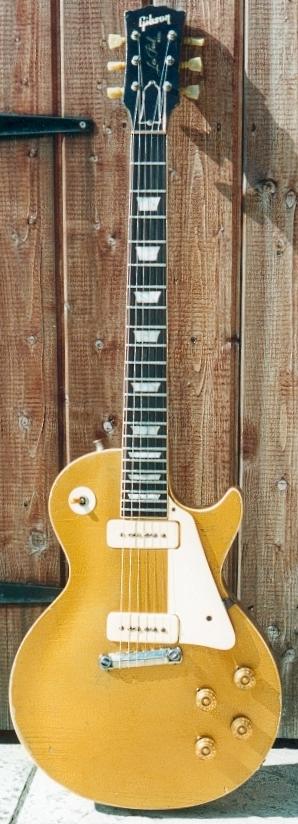
XTC's journey to the U.S. in the spring of 1986 to work with Todd Rundgren has been well-documented elsewhere, though what made it particularly memorable for me was my acquisition of an original 1950's Les Paul guitar – something I'd dreamt of owning since I was a kid.
When Gibson launched the Les Paul in 1952, it was the only solid-bodied non-steel guitar they produced, though variations on the basic theme would appear throughout the fifties.
Constructed from a single slab of mahogany 2" thick, capped with 2 or 3 pieces of ½" maple carved to resemble an arch-top and sprayed gold, it was a serious looker that produced a big, warm tone – quite unlike the twangy new Fenders that were beginning to proliferate the guitar market.
The one innovation that didn't work on its introduction was a huge trapeze-style bridge/tail-piece, in which the strings were fed underneath the bridge-bar, making string-damping with the right palm very awkward. After less than a year in production, a simple solution to the problem was found by mounting the bridge on two steel studs sunk into the top of the guitar, and wrapping the strings over the bar, which could be adjusted for string length by two grub-screws at the rear. Mine is one of the very first with this arrangement – my favourite, just like Nigel Tuffnel's! – though by 1955 it would be modified again to include a bridge separate from the tail-piece, the ABR-1 Tune-O-Matic.
Having spent my career experimenting with a variety of guitars, pick-ups, amps and pedals in a quest for The Perfect Tone, the arrival of this guitar proved once and for all that the solution lies in the timber. These guitars were constructed from woods from the Garden Of Eden, I swear, and crafted by God's little helpers at the Kalamazoo plant. While Gibson currently produce an impressive range of Les Paul re-issues, none can boast what the fifties literature proclaimed the "Les Paul tones". More's the pity…
An apocryphal account of my eating habits during the "Skylarking" sessions (that appeared in Farmer's Song Stories) claims that I was feasting on haute cuisine most evenings, whilst my band-mates made do with bung-hole cardboard pizzas. Not true! I was eating very cheaply indeed, in order to save as much per diem as possible to buy another guitar.
Making records was the only way we got any money at all from the record company at that time. I'd drive to the supermarket in Woodstock, load up with the cheapest cuts of meat, mince, frozen chicken and a bare minimum of fresh vegetables, and made it last. The cash I'd saved was stashed away, and by the time of our last two days in San Francisco I'd managed to scrape together nine hundred of your American dollars.
In the mid-80's, the big money was going on pre-CBS Fenders – Les Pauls were pretty unfashionable, and there were plenty about. I found two elderly gold-tops hanging on the wall in a large music store, thick with dust, neglected and scruffy. One was a '52 with the big trapeze, sprayed gold front and back; the other, this one, lacquer hacked off the back by years of belt-and-buckle abuse, cuts and bruises everywhere, original frets worn down to less than a millimetre and a fingerboard so badly pitted you could have planted spuds in it. The machine heads had been changed, and the original bridge studs had been replaced by some crappy seventies chrome-plated ones that were the wrong size and consequently useless for holding the bridge correctly, which sat at an absurd angle with the strings sitting ¼" off the fret-board. I plugged it in, and the sound that came out of it was unreal. After a lot of begging and pleading with the staff (God bless 'em!), my 900 in cash finally got the better of them and I left the store with the prize of my life.
Back again in Woodstock, I scoured Todd's workshop for a means of fixing the bridge problem, eventually finding a steel washer which I proceeded to saw in half, using the two pieces to shim the gap between the shoulder of the bridge and the top of the stud. They're still in place to this day. Once back in England, a visit to Jonny Kinkade put his genius to work "shooting" and re-fretting the finger-board with some meaty, jumbo frets and a brass nut. (I thought it might match the gold better…doh!) I later had the bridge re-plated, and have replaced the tuners with new single-ring Klusons. All the electrics are 100% original; in 48 years, not so much as a control pot has been changed, and they still operate perfectly, and silently. I'm proud to say that I brought this guitar back from the dead, and it's repaid me tenfold over the years.
A truly fabulous guitar.
Recording debut: XTC: Dear God (May 1986)
Features on: Extrovert (solo);
The Man Who Sailed Around His Soul (XTC, Skylarking, 1986);
Little Lighthouse; You're My Drug (Dukes Of Stratosphear, Psonic Psunspot 1987); Garden Of Earthly Delights; The Loving (solo); Merely A Man (wah-wah); Across This Antheap (A.P.) (XTC, Oranges & Lemons, 1988);
Let Me Change Your Mind Tonight (solo) (Johnny Hates Jazz, 1990);
The Ugly Underneath (E-bow);
Books Are Burning (end solos) (XTC, Nonsuch, 1991);
Queen Phyllis Of Colchester (Martin Newell, The Off-White Album, 1994)
Inside The Dream (solo) (Becki diGregorio, Seven Worthies…, 1986); etc.